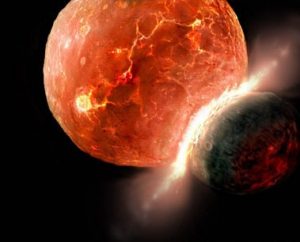 Planets form through bigger and bigger impacts, resulting in a more and more violent collisions. The Earth and the Moon are believed to have formed after a collision between two giant proto-planets of the size of Venus and Mars. In this event, the majority of Earth’s core is believed to have formed.
Planets form through bigger and bigger impacts, resulting in a more and more violent collisions. The Earth and the Moon are believed to have formed after a collision between two giant proto-planets of the size of Venus and Mars. In this event, the majority of Earth’s core is believed to have formed.
During my master’s thesis, David Stevenson and I worked to understand core formation in Earth during impact driven planet accretion, because the style of core formation plays an important role in the determination of age of the Moon and the Earth.
The formation of Earth and terrestrial planets took place in the first ~100 million years of our solar system. The oldest rocks on Earth are 4,000 million years old, and single zircon minerals condensed up to 4,400 million years ago. Yet, the solar system formed 4,567 million years ago and the Earth sometime in between.

Our study emphasizes the importance of chemical mixing between the silicate mantle and metallic cores of the impacting bodies. We show that the enrichment of siderophile 182-W in the Earth’s mantle is likely a result of incomplete mixing and a later giant impact less than 4,500 million years ago. Initial calculations with the short-lived Hf-W chronometer overestimated the age of core formation. The scientific problem is illustrated here.
References:
Dahl & Stevenson EPSL (2010): Turbulent mixing of metal and silicate during planet accretion – And interpretation of the Hf-W chronometer Press release
Perspective in Science: Identifying remnants of early Earth
